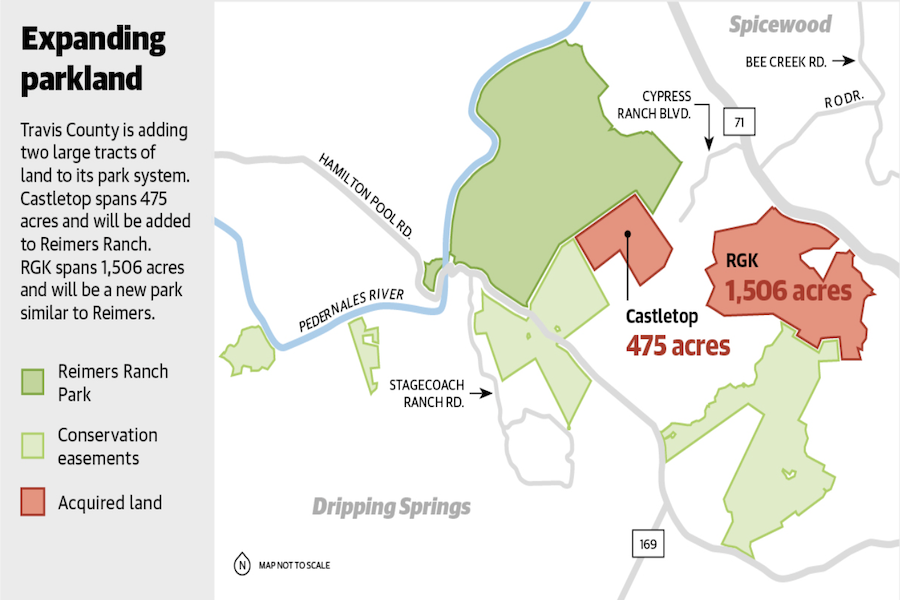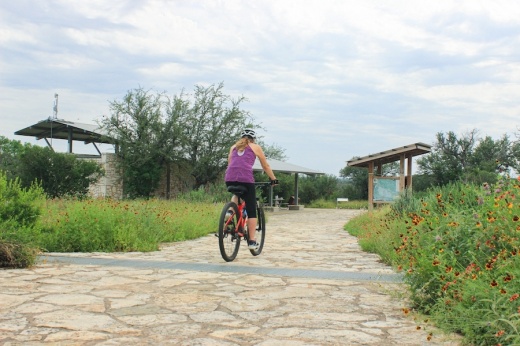“[It was like], ‘Oh my gosh, this has been in our backyard all these years,’” Hegemier said.
Years later, she still regularly visits the park, and the Travis County Parks Foundation is working to increase awareness and accessibility of its parks.
In May, Travis County purchased thousands of acres west of South Austin to preserve green space and expand its park system; the two-pronged approach required a November bond and land donations from two families. Officials said the land would have been developed into hundreds of homes.
“[This will] change the face of the outdoor space available for people to use,” said Joanna Wolaver, Travis County Parks Foundation executive director.
Two-minute impact
In April and May, Travis County acquired almost 2,000 acres of land in the Hill Country and will purchase several smaller parcels along the Eastern Crescent this year after residents voted in November to raise their tax bills to protect green space.
The new land will be used to build upon the county’s 27 parks, which span over 11,000 acres and feature hiking and biking trails, natural swimming holes and fishing areas.
The acquisitions will protect environmentally sensitive land from being turned into dense development, and parks foundation officials hope the new 70-mile trail system will increase accessibility to nature to a historically underserved area.
“Time and time again, Austin voters, in either Travis County elections or city of Austin elections, have voted overwhelmingly to fund these kinds of acquisitions,” said Jeff Francell, director of land protection for The Nature Conservancy. “They want to put their money where their mouth is, and they support it.”
The details
The first tract the county acquired spans 475 acres directly adjacent to Reimers Ranch Park. The land will become an extension of the park with trails, picnic areas and other amenities.
The tract was appraised at $45 million and slated for a 950-home development, but the Topfer family, who owned the land, agreed to sell it to the county instead in late April for $5 million less, saving it from development, Travis County Parks Director Charles Bergh said.
The second parcel, located just east of Reimers Ranch, spans 1,506 acres and was slated for 1,500 homes, Bergh said.
The land was originally purchased in 1970 by Ronya and George Kozmetsky as a family ranch with rolling hills, canyons and vistas. The ranch was later inherited by their daughter, Nadya Scott. The family received offers to buy the ranch for over $130 million, but agreed to preserve it by selling it to the county for $90 million, marking the largest land value donation in Travis County history, officials said.
Travis County officials plan on turning that 1,506-acre chunk into a new park named RGK after Ronya and George Kozmetsky. The park will be similar to Reimers Ranch, complete with hiking and biking trails, restrooms, and picnic areas.
Travis County Commissioner Ann Howard said the acquisition happened just in time.
“Development was eminent,” she said. “The families had many offers to buy the land from as far away as Dubai.”

What else
Travis County has been slowly and quietly acquiring land along the Eastern Crescent for several bond cycles with the vision to create a 70-mile trail system that begins at Northeast Metropolitan Park in Pflugerville and winds all the way down near SH 45, Wolaver said.
The trails will be 12 feet wide and equipped with restrooms, water fountains and other amenities. Wolaver said the winding trails will connect with other local greenways, including the Walnut Creek Regional Trail, the Ann and Roy Butler Hike and Bike Trail, and the Violet Crown Trail.
When the 70-mile trail is complete, Central Texans could walk or bike from Pflugerville to downtown Austin to the southern tip of the Violet Crown trail, near Buda.
The county will use 2023 bond funds to acquire several more tracts of land for the trail system over the coming months.

The why
Both of the county’s envisioned projects—expanding its destination parks and building a robust trail system on the east side—help achieve the county’s goal of bringing more green space to the masses, Wolaver said.
The county’s vision for the trail system was inspired by the 2019 Healthy Parks Plan, which identified park recommendations for Travis, Bastrop and Caldwell counties.
The report marked many areas east of I-35 and south of Hwy. 71 as low-income areas with a high priority for community health—two factors the study says increased parkland can address.
“Communities facing high social and economic vulnerability may have the greatest need for the services provided by parks, and the most limited ability to travel long distances to access these services or to pay to use private recreational facilities,” the parks study highlights.
Both of the county’s envisioned projects—expanding its destination parks and building a robust trail system on the east side—help achieve the county’s goal of bringing more green space to the masses, Wolaver said.
The county’s vision for the trail system was inspired by the 2019 Healthy Parks Plan, which identified park recommendations for Travis, Bastrop and Caldwell counties.
The report marked many areas east of I-35 and south of Hwy. 71 as low-income areas with a high priority for community health—two factors the study says increased parkland can address.
“Communities facing high social and economic vulnerability may have the greatest need for the services provided by parks, and the most limited ability to travel long distances to access these services or to pay to use private recreational facilities,” the parks study highlights.
What's next
Travis County crews will break ground on the 70-mile trail system on the east side within the next year and a half, starting near Onion Creek to McKinney Falls. County officials do not have an estimate for when the entire trail system will be finished, as it will likely take more bond cycles of funding to complete. County officials will begin planning RGK’s trails and amenities over the next year while also offering guided tours of the land’s rolling hills and wildlife. Officials hope the park will be open to the public by the end of 2025.
In the coming years, the foundation may acquire the remaining land between Castletop and RGK Park, preserving more than 4,000 acres of combined space in the Hill Country.





